Modern World: The Age of Reason | History - Discovery of New Sea Routes to the East | 12th History : Chapter 10 : Modern World: The Age of Reason
Chapter: 12th History : Chapter 10 : Modern World: The Age of Reason
Discovery of New Sea Routes to the East
Discovery of New Sea Routes to the East
The
Turkish conquests and the fall of Constantinople provided stimulus to the European
maritime nations to find a sea route to the East so that they did not have to
The Turkish conquests and the fall of Constantinople provided stimulus to the
European maritime nations to find a sea route to the East so that they did not
have to depend on the old land routes controlled by the Ottomans. These efforts
eventually resulted in the great geographical discoveries which revealed to
Europeans the existence of a New World on the other side of the Atlantic Ocean.
Multiple factors lead to the exploration of sea
(a) During the Crusades, the knights (warriors)
returned with many types of goods from the East. The Europeans liked the
eastern products, mainly the spices, which were used as food preservatives in
the West. Till that time Arabs controlled the land-bound and maritime trade
with the Asian countries including India and further east.
They
exchanged the goods from various parts of Asia with the Italians, who then
traded on them in Europe. The European powers, particularly Portugal and Spain,
wanted to have direct trade with the Asian countries. They therefore encouraged
the exploration of new routes, so that they could profit more. This was the
decisive economic factor that provided the urge to discover new trade routes.
(b) As the demands for the products from the East
increased, the European states wanted to earn more profits and control
sea-borne trade. Hence they were interested in investing in the sea
exploration.
(c) The spirit of the age that ‘let fools contest
elections and the adventurous go and explore’ prompted many to opt for the
latter course that promised both money and fame.
(d) The eagerness to spread religion (Christianity)
also acted as an impetus to the exploration of new lands, though this was not a
primary factor in the initial period. During the time of the Counter
Reformation spreading the word of god gained prominence.
(e) Due to Renaissance there was development of
technology in many fields. One such field was cartography (map-making).
Ptolemy’s map of the first century CE was redrawn using new advances in
techniques. A Renaissance geographer, Gerardus Mercator used the concepts of
latitude and longitude to draw maps that were useful for the navigators.
(f) A new improved design of ships played a crucial
role in the long, risky sea voyages. The building of caravel, a lighter ship
that could easily sail in shallow water, was an important technological
innovation.
(g) The hazards of sea voyages was mitigated by the
availability of firearms and cannons.
(h) Sailors were no longer left to the mercy of a
calm night and the bright stars to determine the direction in which they were
sailing, since the Mariner’scompass was now available in Europe.
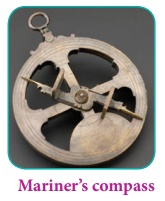
Initiatives of Portugal
Located on the south-western part of Europe, the small country of
Portugalled the way first in exploration, discovering the Canaries, Madeiraand
the Azores. In 1442 Henry, the Navigator sailors sent out by Prince Henry,
the Navigator reached Guinea Coast of Africa and later in 1488 Bartholomew Diaz
rounded the Cape of Good Hope.
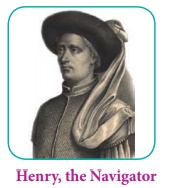
Henry,
the Navigator was a Portuguese prince. Though he never ventured into the sea,
he started a school of navigation at Sagres, Portugal. He hired cartographers,
shipbuilders and instrument makers to help sailors undertake planned voyages.
Christopher Columbus (1451–1506)
Christopher Columbus, an Italian
from Genoa, fough many difficulties before he secured the patronage of the
Spanishrulers Ferdinand and Isabella. On 3 August 1492 Columbus sailed from the
harbour of Palos near Cadiz, with three small ships (the Santa Maria, the Pinta
and the Nina).
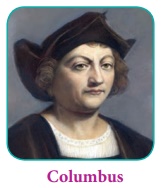
After a voyage of two months and
nine days in 1492 he came to a land which he believed to be India.
But it was really a new continent, America. He returned to Spain with gold,
cotton, strange beasts and two wild-eyed painted “Indians” to be baptised. They
were called Indians because, to the end of his days, he believed that the land
he had discovered was India.
Vasco da Gama
The
success of Columbus prompted Vasco da Gama to start his historic voyage (1497)
to the eastern part. He set sail with four ships from Lisbon and reached the
island of Mozambique. Later he travelled further south and reached Kapad, a
beach near Kozhikode, Kerala. By reaching a part of India, he opened avenues
for direct trade with India. This voyage led to the colonisation of a few
regions in India. One such region was Goa.
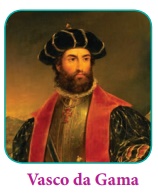
Papal Bull (1493)
The
Spanish kings were apprehensive about the Portuguese venture into sea voyages.
They requested Pope Alexander VI to find a solution. In 1493, the Pope issued a
Papal Bull (proclamation). The proclamation drew a north–south line from pole
to pole, passing around 320 miles west of the Cape Verde islands. It declared
that any new discoveries west of the line belonged to Spain. Portugal was not
happy with the arrangement. The following year (1494) it struck an agreement
with Spain, signing the Treaty of Tordesillas. This arrangement respected the
concept of a north–south line of demarcation, but shifted it to 1,185 miles
west of the Cape Verde islands, and acknowledged that everything discovered
east of it would belong to Portugal. Six years later, in April 1500, this
turned out to Portugal’s advantage, when Pedro Álvares Cabral landed on the east
coast of Brazil, and was able to claim it for Portugal.
Portuguese Navigator Pedro Cabral
In 1500
Pedro Cabral sailed westward and discovered Brazil. Pedro Cabral named the
island as “Island of the True Cross”. Brazil became Portugal’s colony and its subsequent
history is dealt with in Unit XI.
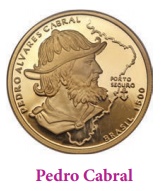
Cabral sailed to India, following the route of Vasco da Gama, and reached Kozhikode. Initially the zamorin ruler was well disposed towards the Portuguese and allowed Cabral to build a fort and carry on trade. However, disputes soon arose with the Arab traders and a large Arab force attacked the trading post and killed many Portuguese soldiers. Cabral retaliated with reinforcements from Portugal. He captured 10 Arab vessels and executed their crews. He then left for Cochin (now Kochi), further south, where he was warmly received and permitted to trade. After establishing a port at Cannanore (now Kannur) Cabral returned on January 16, 1501, with six shiploads of spices to Portugal. On his way, however, two ships failed, and Cabral finally reached Portugal with four ships on June 23, 1501.
Voyage of Magellan
Ferdinand
Magellan, a Portuguese sailor got Spanish support to explore the world. With
five ships he sailed out of Seville westward in 1519. He found a strait at the
tip of South America and named it the Strait of Magellan. From there the crew
reached the Great South Sea. As the sea remained calm, he called it Pacific
Ocean (Pacifico means peaceful in
Spanish). In the voyage, Magellan lost two of his ships and many of the crew
due to disease. Magellan himself was killed in the Philippie Isles. Finally, a
single ship, the Vittoria (or
Victoria) with 18 sailors returned to Seville in 1522. Vittoria was the first
ship that ever circumnavigated the world.

Turks,
French, English, and Germans had not yet realised the significance of the new
sea routes to Asia. They were yet to understand the political importance of the
European discovery of America. Hernan Cortes, a Spanish Conquistador, with a
mere handful of men conquered the Empire of Mexico for Spain. Pizarro crossed
the Isthmus of Panama (1530) and subjugated another country Peru, destroying
the Inca Empire in south America.

Other Important European Expeditions
Following
in the footsteps of the Portuguese and the Spanish seafarers, other European
countries started exploring the world. John Cabot, an Italian explorer, was
commissioned by England to find new lands across the globe. On his voyage he
saw Canada and made it an English colony. Giovanni da Verrazano, another
Italian, explored the lands for the French. He annexed provinces for the French
in eastern Canada. An English explorer named Henry Hudson wanted to find the
passage from North America to the Pacific Ocean. Though he failed in his
initiative, he explored the region which now bears his name – Hudson River.
Catastrophic Impact of Spanish Arms: Although the Aztecs had
superior numbers, with firearms and steel blades at his disposal, just one
Spaniard could annihilate dozens or even hundreds of opponents: “On a sudden,
they speared and thrust people into shreds,” wrote one indigenous chronicler, a
witness to the terrifying impact of European arms. “Others were beheaded in one
swipe... Others tried to run in vain from the butchery, their innards falling
from them and entangling their very feet.” A smallpox epidemic outbreak
weakened the Aztec while giving Cortes time to regroup, resume fighting and
finally emerge victorious.
Due to
the rising competition from England, there was conflict between Spain and
England. Francis Drake annexed California region for the English, despite
protests from Spain. This led to war between the two nations. In 1588 King
Philip II of Spain sent an armada or Spanish fleet of 130 vessels and 31,000
soldiers to invade England. However, the English with their easily manoeuvrable
fleet easily destroyed the Spanish Armada. This marked the rise of the British
as an important power in modern world.
Related Topics